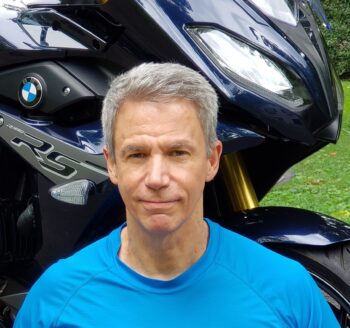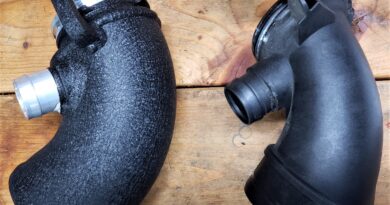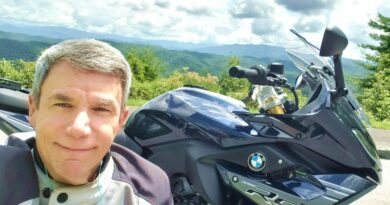Points of interest
In her recent article, “Mastering Your Machine: Small Changes Often Make the Biggest Impact”, Kandi Spangler related an illustration from her pilot training wherein her instructor barked, “Feel your butt!” This was meant to direct her attention to bodily sensations resulting from the plane’s movements, specifically how her weight did or didn’t shift in the seat while performing acrobatic maneuvers. Focusing on her butt-seat interface supplied information in a more helpful way than the instrumentation Kandi might have otherwise referenced, allowing her to look elsewhere. It also prioritized the use of her visceral, proprioceptive senses over more abstract, intellectual processing.
 During a skill drill yesterday, that exhortation in Kandi’s account was exactly what I needed to hear. I was working on low-speed, full-lock turns in an empty parking lot, doing circles, figure-8s and U-turns within cone arrangements limiting my arc diameters to under 20 feet. I’ve been able to do slightly tighter configurations in the past, but I was stiff and rusty during this mid-winter outing and could barely manage what I’d hoped would be merely a warmup. I couldn’t identify what was giving me trouble. I’d made sure to turn my head and eyes so I was looking far around the curve I wanted to trace. I was balancing throttle, clutch and rear brake adequately in my efforts to maintain steady speed without threatening a stall or fall. And I was counterweighting the bike with my torso to allow sufficient lean angle at just above a walking pace. I know I often forget to hinge properly at the waist when I haven’t ridden for a while, so I was also deliberately letting my hips swivel with the bike underneath me while sliding my shoulders across to the outside of the turn. All this worked, but just barely, and without the relaxed, comfortable physicality required for graceful execution.
During a skill drill yesterday, that exhortation in Kandi’s account was exactly what I needed to hear. I was working on low-speed, full-lock turns in an empty parking lot, doing circles, figure-8s and U-turns within cone arrangements limiting my arc diameters to under 20 feet. I’ve been able to do slightly tighter configurations in the past, but I was stiff and rusty during this mid-winter outing and could barely manage what I’d hoped would be merely a warmup. I couldn’t identify what was giving me trouble. I’d made sure to turn my head and eyes so I was looking far around the curve I wanted to trace. I was balancing throttle, clutch and rear brake adequately in my efforts to maintain steady speed without threatening a stall or fall. And I was counterweighting the bike with my torso to allow sufficient lean angle at just above a walking pace. I know I often forget to hinge properly at the waist when I haven’t ridden for a while, so I was also deliberately letting my hips swivel with the bike underneath me while sliding my shoulders across to the outside of the turn. All this worked, but just barely, and without the relaxed, comfortable physicality required for graceful execution.
Fortuitously, the quote from Kandi’s flying lesson came to mind. I don’t know how this had escaped me in the past, but I suddenly and vividly noticed my outer sit bone pressing into the saddle as I rounded a few more laps of my little circle course. I found if I just paid attention to that single reference point, everything else fell into place. I was no longer frantically juggling multiple balls in my mind. Yes, I still saw the cones in my peripheral vision with my eyes and head rotated, I still played the throttle against the clutch and the clutch against the rear brake, and I still held my torso upright with the bike tilted below, but all of those considerations were subordinated to the simple act of feeling my butt—actually just half of it—pushing down into my seat. It was like being in a trance, with all the normal sensory inputs from the external world muted and the volume turned way up on this solitary interior channel. Of course, that information had been available to me all the time, but it hadn’t been figural in my consciousness.
This is an easy principle to demonstrate. Until I call your attention to it in the following phrase, you probably haven’t been aware of your own butt pressing into whatever you’re sitting on—but now you are! Our senses deliver a perpetual avalanche of incoming information to our brains, vastly more than our narrow capacity for attention can handle. Our nervous systems automatically filter out almost all of what’s competing for acknowledgement so we have half a chance of focusing on what’s most important. We possess limited ability to deliberately change what’s allowed in and what’s ignored, but anxiety and preconceived notions can make such willful selectivity quite difficult or cause us to overlook what we might otherwise readily perceive.

In the example of my parking lot drills, my own internal Filter HQ was compelled to prioritize a) factors naturally indicating physical danger, like any sensation suggesting the bike was about to fall, and b) conceptual instructions I believed were relevant to avoiding such a potentially injurious event and—secondarily—supported completing my maneuvers without clipping any cones or dabbing my foot on the ground. Since I was out of practice, I was more prone to alarm about tipping over, which intensified my focus on three salient remedies from my history of training and experience: correct vision direction, upper body location and waist flexibility. While these allowed nominal success, I remained physically tense and mentally scattered (both due to anxiety), and the bike’s behavior was consequently jerky and wobbly. By contrast, when I seized upon my outer sit bone as the point of interest, my efforts were instantly rendered more efficient and effective, which helped me relax and utilize more nuanced control inputs, thereby coaxing smoother motion from my machine. I could lean the bike further without fear, effortlessly tightening my arc. In this instance, it wasn’t difficult to shift my focus to a more useful target; the bigger challenge had been figuring out what that target should be. Other times, I might have a clear idea what ought to be my focus, but anxiety fragments my concentration and makes it harder to forcibly highlight the chosen element in my perceptual field.
The most dramatically transformative experience I’ve had along these lines occurred during formal instruction at the Trials Training Center in Sequatchie, Tennessee. As in my low-speed cone exercises, we trainees were trying to navigate a series of gates requiring restrictively tight turns. Such turns demanded leaning our motorcycles sharply in one direction while leaning our bodies in the opposite direction. Because we were moving at less than a walking pace, the angles of bike and body had to be much more extreme than what I was doing on my street bike in that parking lot. I struggled to discern and execute the requisite degrees of tilt, trying to judge them indirectly by watching others and visualizing my own positioning of bike and body—not unlike looking at a set of instruments and mentally assessing their conformity with an abstract ideal. Although I was paying attention to my body, I had no specific focus. I was the equivalent of a toddler, sending spastic impulses to my muscles without knowing which ones were truly relevant for the task at hand; I could make forward progress, but with much extraneous effort and movement, and some elements missing altogether.
The Ride Inside with Mark Barnes is brought to you by the MOA Foundation. You can join the BMW Motorcycle Owners of America quickly and easily to better take advantage of the Paul B Grant and Clark Luster programs mentioned in this episode.
The game changer for me was one pithy command from our instructor: “Feel the bike against your leg!” If you’re unfamiliar with modern (single-shock) trials bikes, they have no seat. Their midsections are scooped out to follow the frame rails descending from steering head to rear suspension mount. This design allows the rider (always standing on the pegs) to pivot the bike beneath them to extremes otherwise blocked by the presence of a saddle. When a trials bike is tilted far to the left and the rider is tilted far to the right, the low “waist” of the frame, or the ascending arch of the rear fender, contacts the rider’s lower left leg. Once I focused my attention on this crucial detail, I could dispense with many other variables. My bike and body both felt secure as I directly sensed them bracing against each other, and I could devote the remainder of my attention to line selection instead of worrying about balance. With time, I didn’t even have to spend precious attention on this point of contact. It became part of my muscle memory and functioned without conscious thought, only entering my awareness when I was more strenuously “bending” the bike around an obstacle. Such increased exertion involved extra pressure at the contact point, but rather than being a distraction, this was just the tactile confirmation of an intended process already underway.

I thought about this trials bike technique while I worked on counterweighting during my pavement drills, but I couldn’t come up with a corollary. I even tried standing on the pegs to see if I could get some familiar feedback where my leg and motorcycle made contact, but it wasn’t the same. My serendipitous memory of Kandi’s article finally supplied the necessary prompt, and having a better reference point made a world of difference. I can’t recall what focus I’d used to negotiate this challenge previously, but it definitely wasn’t as efficient. A similar example is locking my outside knee against the tank entering faster corners. When I focus on accomplishing this one action, my butt scoots to the inside, my hips twist slightly in the same direction, and my inner knee starts to extend down. It’s a “package” of lower body dynamics I can activate with a single intention, rather than an itemized list of muscle group orders. My lower body then forms a stable base, letting my arms steer more freely, and orients my upper body with the correct tilt and rotation—a domino effect. Such packaging is the result of repetitive practice linking those individual elements together in muscle memory, ultimately yielding a streamlined method of getting a lot done with a modicum of attention, as long as I ride often enough to avoid muscle dementia! Otherwise, retraining is required.
A highly adept rider can gauge their bike’s steep lean angle by how far the tarmac has pressed their hanging knee back toward their bike’s chassis. Visual reference points on a racetrack include braking markers approaching a turn, as well as stationary landmarks used for positioning and aiming on the way into a blind corner. On the street, we might use subtle details in the landscape for reference in predicting the direction of an upcoming turn, or anticipating the need to slow because a hidden side street may await below a gap in the visible tree line ahead. These are all ways of strategically focusing our senses to better serve us in the tasks of riding. Which points are most useful as targets of sensory interest is a somewhat idiosyncratic matter, with different riders relying upon different references. However, most of us can benefit from learning what POIs others use. What have you found to be the most minimalistic necessary-and-sufficient reference points in mastering various riding challenges? Compare notes with your buddies to see what you can learn from each other’s distillations. Each of you may hold a key unlocking new levels of proficiency and confidence for the other.
Thanks, Kandi, for getting me more interested in my butt!
Mark Barnes is a clinical psychologist and motojournalist. To read more of his writings, check out his book Why We Ride: A Psychologist Explains the Motorcyclist’s Mind and the Love Affair Between Rider, Bike and Road, currently available in paperback through Amazon and other retailers.




